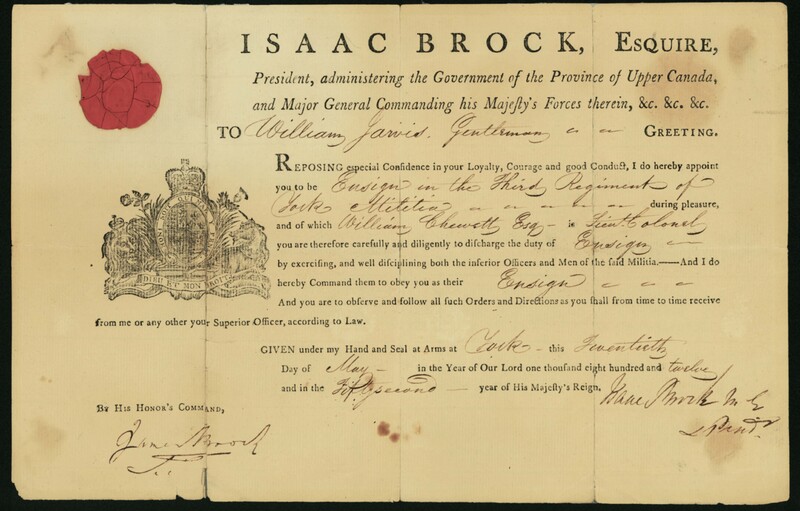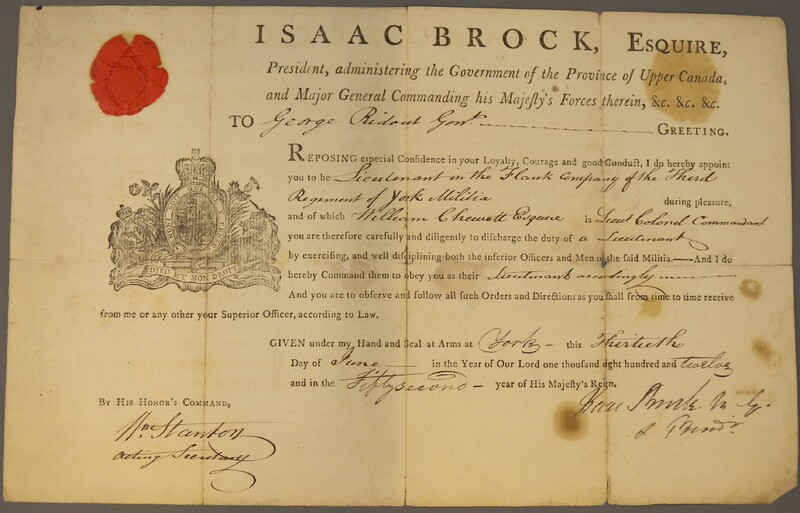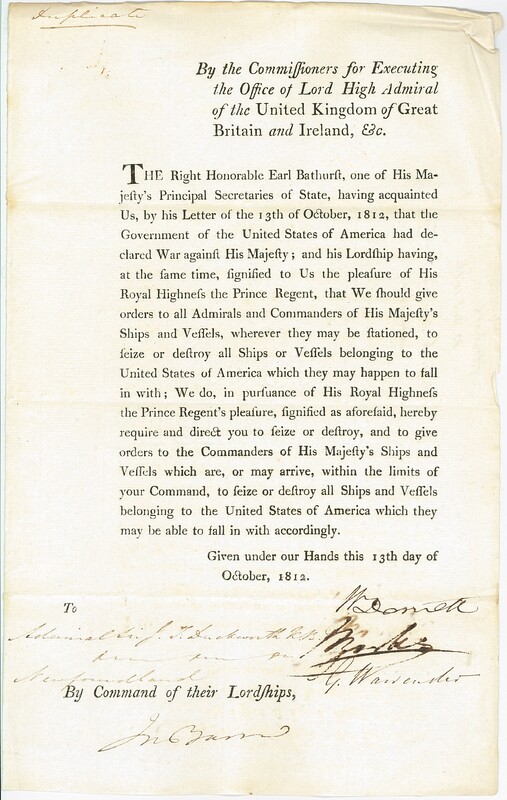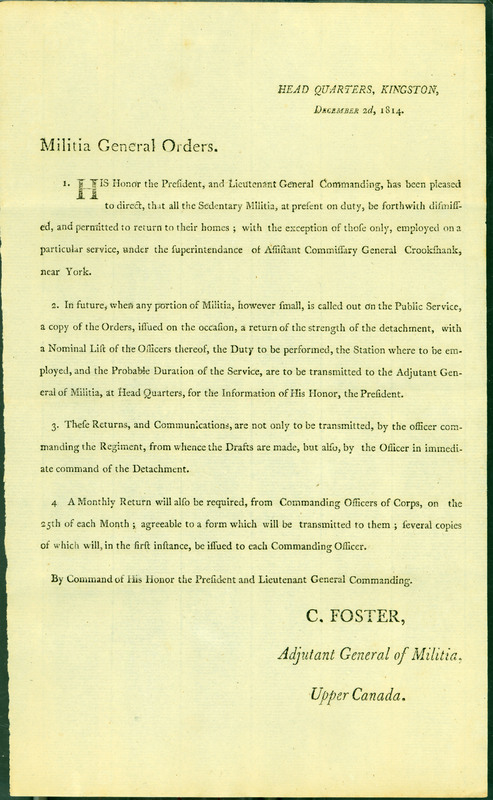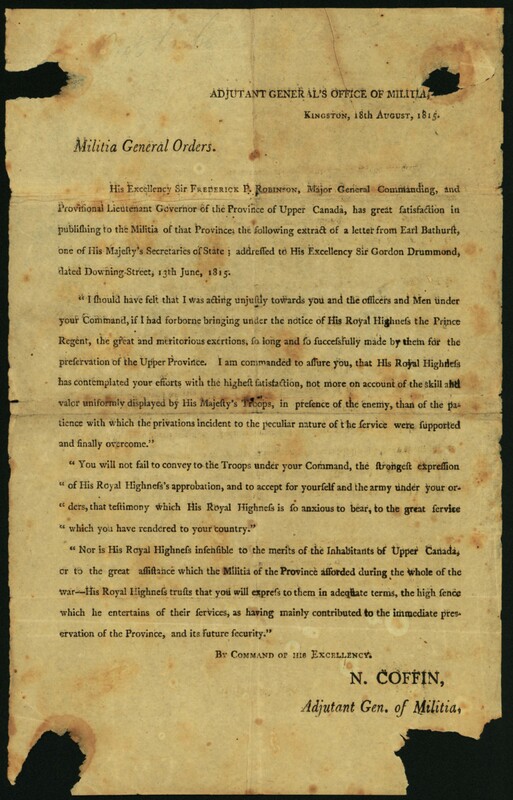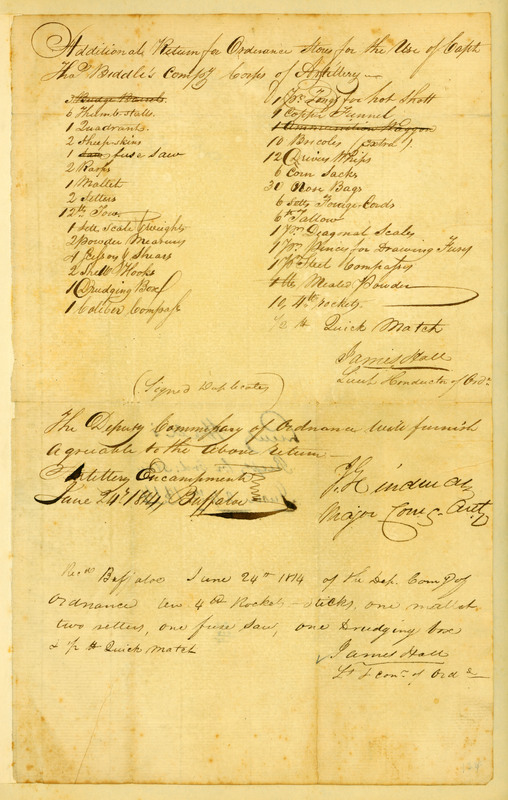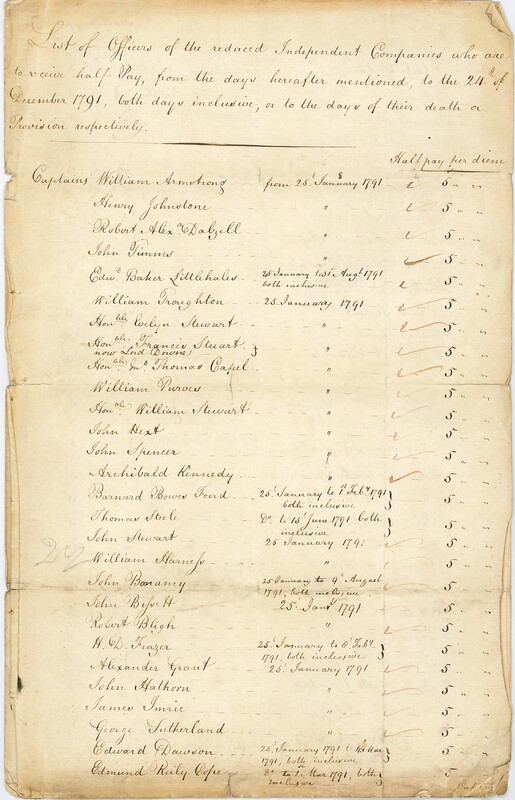Military Documents
Military Appointments
Several military appointments formally assigning citizens to militia regiments can be found in the War of 1812 collection. These documents are all signed by Isaac Brock. There are military appointments for George Ridout, Joseph Berny, and William Jarvis.
George Ridout was a member of the York Volunteers. He served as 3rd lieutenant in the grenadier company of the York militia, fought in the battle of Queenston Heights, and was taken prisoner of war in April 1813 when the Americans occupied York. He went on to become an active member of the Law Society of Upper Canada.
Joseph Berney was appointed to the position of Ensign in the Fifth Regiment of the Lincoln Militia. Berny was one of the soldiers to see Brock fall at the battle of Queenston Heights. He was on duty in December of 1812 with a detachment at the whirlpool below Niagara Falls, but his men deserted him on January 5, 1813. Berney also led the 5th Lincoln in the Battle of Lundy's Lane in 1814.
William (Munson) Jarvis joined the 3rd Regiment of the York Militia and fought at Queenston Heights and Stoney Creek. He also fought at the Battle of York on April 27, 1813 where he was wounded and captured. He was later released but suffered damage to an eye during the altercation. He later served as High Sheriff of the District of Gore.
RG 402 George Ridout Military Appointment
RG 563 William Jarvis Military Appointment
RG 689 Joseph Berny Military Appointment
Orders
Admiralty Commissioner's Orders, October 13, 1812
These orders were addressed to Admiral Sir Thomas Duckworth, Governor and Commander-in-Chief of Newfoundland, informing him of America's declaration of war against Great Britain and instructing him to seize and destroy all ships belonging to the United States of America which he may encounter. The document is marked as a duplicate. It is likely that several copies were issued and sent via different ships to ensure that at least one made it to Admiral Duckworth.
RG 446 Admiralty Commissioner's Orders
General Order, October 7, 1814
This broadside contains a general order noting the British capture of two armed schooners, the Tigress and the Scorpion. This was planned and executed by Lieutenant Worsely of the Royal Navy and a detachment of 50 rank and file of the Royal Newfoundland Regiment.
RG 690 General Orders from Edward Baynes, 1814
Militia General Orders, December 2, 1814
These orders disband the militia at the conclusion of the War of 1812 and were authorized by C. Foster, Adjutant General of Militia, Upper Canada. The order states that "His Honor, the President and Lieutenant General Commanding, has been pleased to direct, that all the Sedentary Militia, at present on duty, be forthwith dismissed, and permitted to return to their homes, with the exception of those only, employed on a particular service, under the Superintendence of Assistant Commissary General Crookshank, near York".
Orderly Book, 1812-1813
This orderly book of the Second Regiment of U.S. Dragoons, New York, contains orders pertaining to daily military matters such as punishments for disobedience, court-martial proceedings, camp rules and regulations, and guidelines for interacting with civilians in the vicinity of the camp. The Regiment was stationed at various locations in upstate New York and Canada including Greenbush, Albany, Sackets Harbor, Utica, Geneva, Fort Niagara and Fort George. General Henry Dearborn originally commanded the Regiment at Greenbush.
RG 492 Orderly Book, Second Regiment of U.S. Dragoons, New York, 1812-1813
Massachusetts Regiment Orderly Book during the War of 1812
An orderly book of the Massachusetts militia at Lanesborough. The entries in the book are dated from May 1811 to 1836. Various other entries are included throughout the book with dates ranging from 1862 to 1868. The Captain of the militia unit is Samuel Northam. Entries include muster rolls, regimental orders, and parades.
RG 740 Massachusetts Regiment Orderly Book during the War of 1812
Militia General Orders, August 18, 1815
The order consists of four paragraphs of a letter from Earl Bathurst to Sir Gordon Drummond. The letter expresses thanks to Drummond and his troops. It is stated that "You will not fail to convey to the troops under your command the strongest expression of His Royal Highness's approbation and to accept for yourself and the army under your orders, that testimony which his Royal Highness is so anxious to bear to the great service which you have rendered your country."
The role of the Militia is also acknowledged. It is stated that "the great assistance which the Militia of the Province afforded during the whole of the war--His Royal Highness trusts that you will express to them in adequate terms the high sence which he entertains of their services, as having mainly contributed to the immediate preservation of the Province, and its future security".
Lists
Return of Ordnance Stores, Buffalo, 1814
A return of ordnance stores for Capt. Biddle's Company Corps of Artillery at Buffalo provides a list of supplies, including a quadrant, powder measures, and rockets. The document is dated June 24, 1814. These supplies were likely used in the defense of Fort Erie in August 1814, when the fort was attacked by the British in an attempt to reclaim it from the Americans.
RG 413 Return for Ordnance Stores for Capt. Biddle's Compy Corps of Artillery
List of Officers to receive half pay, 1791
Isaac Brock and his brother Irwin appear on a list of officers of reduced independent Companies who are to receive half pay. The list is dated December 24, 1791.
RG 450 List of Officers to receive half-pay (including Isaac Brock), 1791
Quarterly Return of Captain Benedict's Company, 2nd Regt., Leeds Militia, 1814
The return includes a description of the militia including the number of members of each rank and file, and changes since the last return. The militia was headed by Captain Joseph Benedict. The return is dated September 24, 1814.
RG 716 Quarterly return of Captain Benedicts Company, 2nd Regt, Leeds Militia, 1814
Third Regiment N.Y. State Artillery muster role, 1812-1814
A muster role of the Third Regiment N.Y. State Artillery. The document reads “We the Subscribers do voluntarily enroll ourselves in the Company of the Said Regiment under the Command of William Swaim and do pledge Ourselves to obey him and others our Superior Officers to Conform to the Laws of the said State and the Bye Laws of the said Company”.
RG 775 Third Regiment N.Y. State Artillery muster role, 1812-1814
Other Military Documents
Oath of Allegiance to King George III
An oath of allegiance to King George III by the Second Regiment of the Lincoln Militia was signed by twelve men belonging to the regiment. The oath was sworn at Chippawa on September 4, 1812 before Thomas Dickson, Justice of the Peace.
The Second Regiment of the Lincoln Militia was one of five Lincoln Regiments that existed at the outbreak of war in 1812. The Lincoln Militia participated in every battle in the Niagara Peninsula in the War of 1812.
RG 405 Oath of Allegiance to King George III
Royal Navy Ship Collection
The Royal Navy Ship Collection contains copies of plans of Royal Navy ships, ranging in date from 1784 to 1816. Many of these ships were used by the British during the War of 1812. The original plans are at the National Maritime Museum in Greenwich, London. Other items of interest in this collection are a handwritten chart with the number and size of the British and United States Squadrons on Lake Ontario in March 1814, and a map tracking the movements of the HMS Java and the USS Constitution, dated December 29, 1812.
The HMS Java and USS Constitution engaged in battle on December 29, 1812. Both ships were damaged in the altercation, with the HMS Java suffering the most damage. The British ship surrendered to the Americans. It was not possible to tow the Java to an American port, so the Americans destroyed it instead. When news of the incident reached England the British Admiralty issued orders forbidding captains from individually engaging American ships in battle.
RG 423 Royal Navy Ship Collection
Broadside by Alexander Smyth, 1812
This broadside issued by Alexander Smyth from the Camp near Buffalo is dated November 10, 1812. It is addressed “To the Men of the state of New York” and was issued during the War of 1812. Smyth hopes to raise support for an invasion of Canada led by him, and criticizes the efforts made in the war to date.
RG 817 Broadside by Alexander Smyth, 1812
Discharge Certificate for Levi Sawyer, 1816
A certificate discharging Levi Sawyer from Captain William Wilson’s company of the Corps of Artillery, United States, after five years of service.
